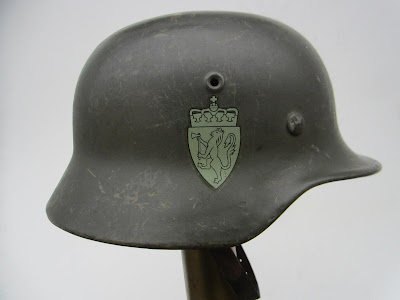From this...
to this...
to this - post war Norwegians soldiers using captured German equipment.
(Thanks to Ray for this image)
On May 8, 1945 the German forces in Norway capitulated, ending four years of occupation. A result of the German's throwing in the towel was the enormous volume of war materiel that they left behind - including tens of thousands of helmets. This wealth of weaponry and equipment was a windfall for the reorganized Norwegian military in the years following the war. German m.35, m.40, and m.42 helmets were repainted, fitted with Norwegian liners, and marked with Norwegian decals.
Here is the walk around of my German m.40 dragooned into postwar Norwegian service.
For my post on the German m.40 go here
The liner is the original German m.31 liner dyed a reddish-brown by the Norwegians.

Though indistinct, the marking under the liner appears to be the numeral 57.
This helmet retains the original German chinstrap - manufactured in 1941 by Wilheim Eilers of Bielefeld. This is a particularly crisp marking and was a very pleasant surprise
to find on this helmet
A production number is on the rear skirt.
On the inside of the skirt is the mark of the manufacturer - Emaillirwerk A.G. of Fulda, as well as the size - 64
The chinstrap is attached to the bails with a double-headed stud.
This chinstrap, like all early to mid-war German materiel is of very high quality.
The m.40 was the last model to have the rolled edge. The later m. 42 had as raw edge to expedite production and lower cost; both important factors in a Reich of declining fortunes.
The olive green underneath the darker green is an earlier version of the Norwegian color.
The main difference between the German m.40 and the earlier m.35 is the ventilator hole. The m.40, like the later m.42 is stamped. The m.35 ventilator is a separate bushing. Here too is the distinctive insignia of the Norwegian army.
And a final shout-out to the beloved King Haakon VII who, from exile, held it all together for Norway in his struggles against the Nazis.






























